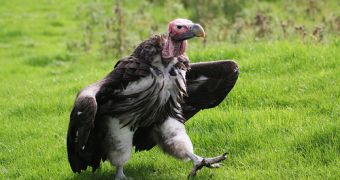A new research carried out by Dr Andrew Bamford from Nottingham University, concluded that Vultures use face flushing technique when interacting with other vultures, and also as a display of dominance.
“Updating” your status is not something that was always linked to technology, it is rather a habit that could come from animals, and more specifically from vultures.
Dr Bamford and his team have studied Lappet-faced vultures Aegypius tracheliotos in northern Namibia, and found out in what way do they use their face changing color ability.
To do so, the scientists placed food in places where they knew vultures will gather at sunrise and then observed the interactions between the birds.
After careful observation, they noted that the color of the vultures' heads was very important, for example, adults with flushed heads won most social interactions against adults with pale heads and against young vultures.
On the other hand, adults with pale heads had no success whatsoever against juveniles.
The team also discovered something they did not know: blue colored heads always won, whether it was against juveniles, pale or even red throated vultures.
The ability to rapidly change color is not something new, it has already been observed in reptiles and fish, and they use specialist cells to disperse and concentrate pigments.
But this is the first time that a research of the effects of face flushing is focusing on vultures.
“Vultures have un-feathered sections of skin on their heads which can become bright red when blood flow is increased, a technique known as flushing,” said Dr Bamford.
“The advantage in using their bare skin as a signal is that color changes can occur more rapidly than in feathers or fur, provide up-to-date information on status.
“Our study has shown coloration correlates with the outcome of interactions in gatherings of lappet-faced vultures,” he concluded.
“Previously interaction was thought to depend on aggressive behavior, but face flushing status plays an important part in the initiation of, and response to, interaction from other vultures.”
This research was published in Ethology, AlphaGalileo reports.

 14 DAY TRIAL //
14 DAY TRIAL //